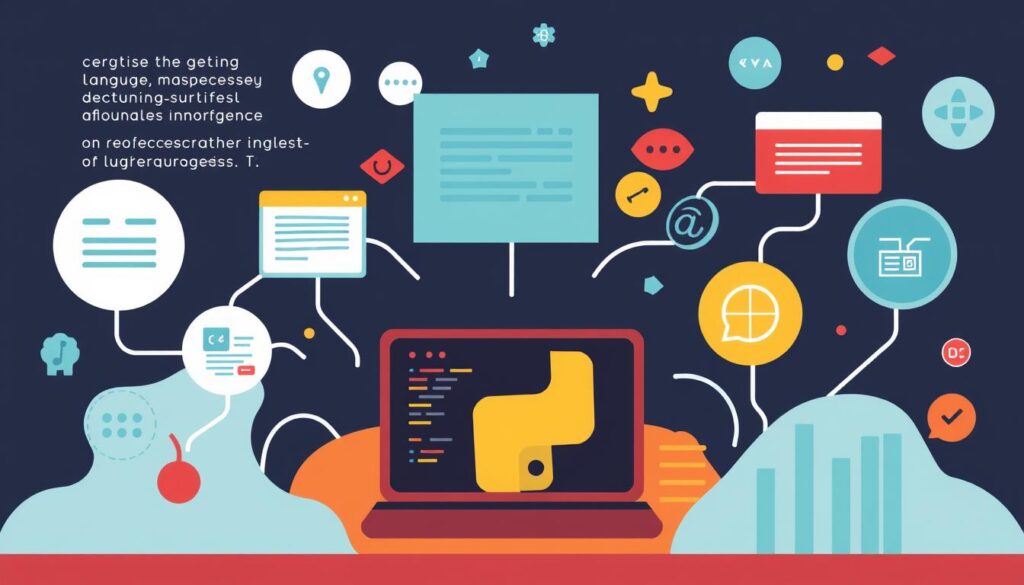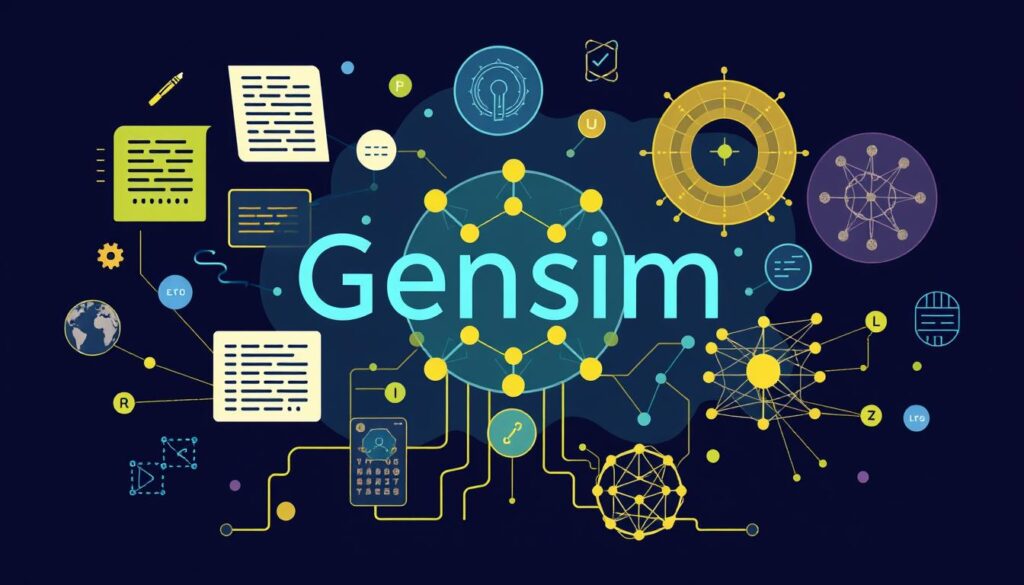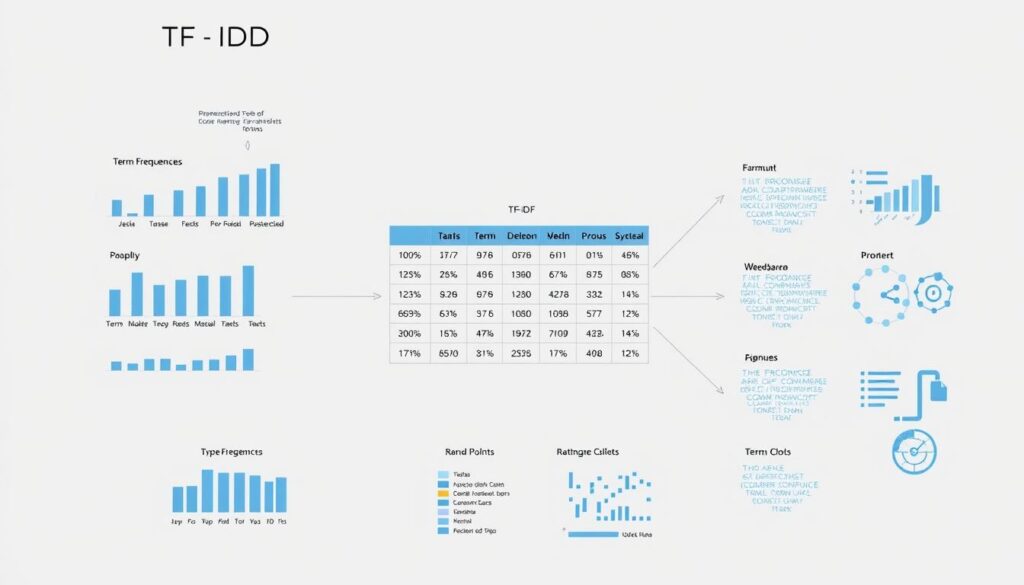Did you know that over 80% of search engine results are influenced by the semantic understanding of content? This staggering statistic highlights the importance of optimizing your content not just for keywords, but for the intent and context that modern search engines prioritize.
NLP techniques are at the forefront of this shift, enabling a more nuanced analysis of text content and its relevance to user queries.
By leveraging Python’s powerful libraries for NLP, you can significantly enhance your SEO strategy, ensuring your content is both visible and relevant to your target audience.
Key Takeaways
- Understand how NLP enhances semantic SEO.
- Learn to analyze text content effectively using Python.
- Discover techniques to optimize content for modern search engines.
- Gain insights into leveraging Python libraries for NLP tasks.
- Improve your SEO strategy with actionable, data-driven insights.
Understanding the Power of NLP in Modern SEO
The rise of Natural Language Processing (NLP) has revolutionized the way search engines understand and process human language, significantly impacting modern SEO. At its core, NLP is a branch of artificial intelligence that enables computers to understand, interpret, and generate human language in a meaningful way.
What is Natural Language Processing?
NLP encompasses a range of techniques that allow machines to process natural language data, such as text or spoken words, meaningfully. It powers various tools and applications we interact with daily, like chatbots, translation services, and voice assistants. By breaking down complex language into analyzable components, NLP helps machines understand the context and meaning behind the text.
The Evolution of Search Engines Toward Semantic Understanding
The evolution of search engines has shifted dramatically from simple keyword matching to sophisticated semantic understanding, where context and meaning take precedence over exact keyword matches. Modern search algorithms like Google’s BERT and RankBrain use NLP to understand the nuances of search queries, including user intent, contextual meaning, and the relationships between words. This shift means that content creators must focus on comprehensive coverage of topics rather than keyword density.
For SEO professionals, understanding NLP principles is becoming essential as search engines increasingly rely on these technologies to determine relevance and quality of content. The practical application of NLP in SEO involves creating content that naturally incorporates related concepts, answers common questions, and provides valuable information that satisfies user intent.
The Intersection of Python, NLP, and Semantic SEO
As search engines evolve, the intersection of Python, NLP, and semantic SEO is becoming increasingly important. This convergence is transforming how we approach search engine optimization by leveraging the strengths of each component.
Why Python is Ideal for NLP Tasks
Python has emerged as the preferred programming language for NLP tasks due to its simplicity, readability, and extensive ecosystem of specialized libraries. The combination of Python’s flexibility and powerful NLP libraries creates an ideal environment for analyzing and optimizing content for semantic search engines. Python’s extensive data handling capabilities allow SEO professionals to process large volumes of text data efficiently, extracting valuable insights that would be impossible to gather manually.
- Python’s simplicity and readability make it accessible for developers to implement NLP tasks.
- The vast ecosystem of libraries such as NLTK, spaCy, and gensim enhances Python’s capabilities for NLP.
How NLP Enhances Semantic SEO Strategy
NLP enhances semantic SEO by helping you understand how search engines interpret your content, allowing you to align your writing with the algorithms that determine rankings. By using Python for NLP tasks, you can identify patterns in successful content, understand topic relationships, and discover semantic connections that can inform your content strategy.
- Python-powered NLP tools can reveal the entities, concepts, and topics associated with high-ranking content.
- NLP helps in understanding user intent patterns and creating comprehensive topic coverage.
As search engines continue to evolve toward understanding meaning rather than matching keywords, the intersection of Python, NLP, and SEO becomes increasingly valuable for creating content that ranks well. Python’s machine learning capabilities further enhance its usefulness for SEO, allowing for predictive analysis and automated optimization based on patterns identified in successful content.
Setting Up Your Python Environment for NLP
To leverage Python for NLP and SEO, setting up the right environment is crucial. This involves installing essential libraries that form the foundation of your text analysis toolkit.
Essential Python Libraries for NLP and SEO
The right libraries are vital for effective NLP and SEO analysis. Some of the most important ones include:
NLTK (Natural Language Toolkit) is fundamental for NLP tasks, providing tools for tokenization, stemming, and lemmatization.

spaCy offers advanced NLP capabilities, particularly for named entity recognition and dependency parsing.

Gensim specializes in topic modeling and semantic similarity analysis.

Scikit-learn provides machine learning algorithms useful for text classification and feature extraction.

Installation and Configuration Steps
Installation is straightforward using pip, Python’s package installer. Configuration involves downloading language models for spaCy and corpus data for NLTK. For beginners, starting with a virtual environment is recommended to keep NLP dependencies isolated.
Fundamental NLP Techniques for Content Analysis
Understanding the core NLP techniques is crucial for effective content analysis in today’s digital landscape. These techniques enable the breakdown and examination of text at a granular level, providing insights that are invaluable for SEO strategies.
Tokenization: Breaking Down Text into Analyzable Units
Tokenization is the process of breaking down text into smaller units, known as tokens, which can be words, phrases, or sentences. This foundational NLP technique allows for the analysis of content at a more detailed level. By using Python’s NLTK library, tokenization can be implemented with ease, transforming large chunks of text into lists of individual words that can be analyzed and processed.
Tokenization Example: Consider a sentence like “The quick brown fox jumps over the lazy dog.” Through tokenization, this sentence is broken down into individual words: [“The”, “quick”, “brown”, “fox”, “jumps”, “over”, “the”, “lazy”, “dog”]. This breakdown facilitates further analysis, such as counting word frequency or examining the context in which certain words are used.
Stop Word Removal: Filtering Out Noise
Stop word removal is a critical step in content analysis that involves filtering out common words like “the,” “is,” and “and” that add little semantic value. By eliminating these stop words, you can focus on the meaningful terms that define your topic. This process helps in understanding what your content is truly about and identifying key terms that search engines might use to categorize your content.
- Stop words are common words that do not carry much meaning in a sentence.
- Removing stop words helps in focusing on the content’s key terms.
- This technique enhances the clarity of content analysis.
Stemming and Lemmatization: Finding Word Roots
Stemming and lemmatization are techniques used to reduce words to their root forms. While stemming simply cuts off word endings, lemmatization uses vocabulary and morphological analysis to return proper dictionary forms. These word normalization techniques are crucial for recognizing different word forms that refer to the same concept, thus providing a more accurate analysis of term frequency and importance.
| Technique | Description | Example |
|---|---|---|
| Stemming | Cuts off word endings | Running -> Run |
| Lemmatization | Uses vocabulary and morphological analysis | Running -> Run |
By applying these fundamental NLP techniques, you can enhance your content analysis, gaining a deeper understanding of your content’s meaning and relevance. This, in turn, can inform your SEO strategies, ensuring that your content is optimized for search engines and resonates with your target audience.
How to Use Python for NLP and Semantic SEO Analysis
Python’s capabilities in NLP and semantic SEO analysis are revolutionizing how we understand and optimize content. By applying advanced NLP techniques, businesses can gain deeper insights into their content’s structure and relevance, ultimately enhancing their SEO strategies.
The process involves several key steps, including analyzing content with TF-IDF, implementing Named Entity Recognition (NER), and extracting topics with topic modeling. These techniques allow for a more nuanced understanding of text and its semantic value.
Analyzing Content with TF-IDF
TF-IDF (Term Frequency-Inverse Document Frequency) is a powerful technique for identifying the most important and distinctive terms in your content. By using Python’s scikit-learn library, you can implement TF-IDF analysis to discover which terms make your content stand out from competitors.
This analysis helps in focusing on the concepts that define your content’s unique value proposition. For instance, TF-IDF scores words based on their uniqueness to a specific document in a larger collection of documents, highlighting important terms that aren’t common across all documents.

Implementing Named Entity Recognition (NER)
Named Entity Recognition (NER) takes text analysis to the next level by identifying and categorizing specific entities such as people, organizations, locations, dates, and products mentioned in your content. With spaCy’s powerful NER capabilities, you can extract entities from your content to understand what specific concepts, brands, or topics your content is associated with.
This understanding is crucial for establishing topical authority in semantic SEO. By recognizing and categorizing entities, you can enhance your content’s relevance and visibility in search engine results.
Extracting Topics with Topic Modeling
Topic modeling techniques like Latent Dirichlet Allocation (LDA) help you discover the hidden thematic structure within your content, revealing the main topics and how they’re distributed throughout your text. By implementing topic modeling with Gensim, you can ensure your content comprehensively covers all relevant aspects of a topic.
This comprehensive coverage is essential for satisfying user queries and meeting search engines’ expectations for content depth. By leveraging these NLP techniques, you can significantly enhance your semantic SEO analysis and strategy.
Building Python Scripts for Keyword Research and Analysis
Python scripts can revolutionize keyword research by leveraging data from Google Autosuggest. By automating the process of collecting and analyzing keyword suggestions, you can uncover valuable insights into user search behavior and preferences.
To start, you’ll need to create a script that interacts with Google’s suggestion API. This can be achieved by using Python libraries like Pandas for data manipulation and Requests for handling HTTP requests. By scraping Google Autosuggest data, you can collect hundreds of keyword ideas in minutes, including long-tail keywords and question-based queries.
Scraping and Analyzing Google Autosuggest Data
Scraping Google Autosuggest data provides insights into user intent, revealing the specific information, products, or solutions people are seeking when they search for terms related to your content. Python’s data manipulation libraries like Pandas make it easy to clean, filter, and organize the keyword data you collect.
For example, you can use Python scripts to analyze the collected data and identify patterns and opportunities within large datasets. This can help you prioritize your content creation efforts based on search volume and relevance.
Clustering Keywords Using K-means Algorithm
Implementing the K-means clustering algorithm allows you to group similar keywords together based on semantic similarity. This helps you organize your content strategy around natural topic clusters, rather than creating multiple thin pieces of content targeting individual keywords.
By analyzing the relationships between keywords in a cluster, you can identify content gaps where users are searching for information that your site doesn’t currently provide. This enables you to create comprehensive resources that address all related aspects of a topic, enhancing your overall SEO analysis.
Using Python scripts for keyword research and analysis can significantly enhance your SEO strategy by providing a data-driven foundation for your content efforts.
Entity Recognition and Relationship Analysis
In the realm of modern SEO, understanding entity recognition and relationship analysis is crucial for developing a robust content strategy. Entity recognition is a crucial aspect of modern SEO as search engines increasingly organize information around entities (people, places, things, concepts) rather than just keywords.
Using spaCy for Entity Extraction
Using spaCy, one of Python’s most powerful NLP libraries, you can extract named entities from your content with remarkable accuracy, identifying the key concepts that define your topic space. The entity extraction process categorizes mentions into types such as persons, organizations, locations, dates, and more, providing a structured understanding of what your content is truly about.
For example, by analyzing the entities present in high-ranking content for your target queries, you can identify the key concepts that search engines associate with expertise on a particular topic.
Mapping Entity Relationships for Content Strategy
Entity relationship analysis goes beyond simple extraction to map how different entities connect to each other, revealing the semantic network that underpins your content area. These entity relationships can be visualized using Python libraries like NetworkX or Plotly, creating knowledge graphs that illustrate the conceptual structure of your content domain.
Understanding entity relationships helps you create content that naturally incorporates related concepts, building topical authority by demonstrating comprehensive knowledge of a subject area. For practical application, you can compare the entity network in your content against competitors to identify gaps in your coverage or opportunities to establish authority on underserved entity relationships.
Implementing Semantic Analysis with Python
By leveraging Python for semantic analysis, we can gain deeper insights into user intent and improve our content’s relevance to search queries. Semantic analysis goes beyond mere keyword matching to understand the context and meaning behind search queries, enabling us to create content that truly addresses user needs.

Understanding User Intent Through Query Analysis
Analyzing user intent involves understanding what users hope to achieve with their search queries. Are they looking to learn something, make a purchase, or find a specific website? NLP techniques can categorize intent into informational, navigational, or transactional categories, allowing us to tailor our content accordingly.
By analyzing search queries with NLP, we can extract patterns to understand not just what users are searching for, but why they’re searching and what they hope to accomplish. This understanding helps in creating content that is semantically relevant to the user’s needs.
| Intent Category | User Goal | Content Strategy |
|---|---|---|
| Informational | Learn something new | Create comprehensive guides and tutorials |
| Navigational | Find a specific website | Optimize content for brand mentions and related searches |
| Transactional | Make a purchase | Enhance product descriptions and calls-to-action |
Content Optimization Based on Semantic Relevance
Content optimization based on semantic relevance involves ensuring that our content addresses all related concepts, questions, and subtopics that users expect to find when searching for information on a topic. Python scripts can analyze top-ranking content to identify semantic fields and reveal gaps in our content, which could be limiting its performance.
By aligning our content with user intent and semantic expectations, we increase the likelihood that search engines will recognize our content as relevant for both target queries and related searches. This approach allows us to move beyond simplistic keyword density metrics and create content that naturally incorporates related terms, demonstrating expertise and authority.
Practical Applications: Python NLP for Technical SEO
Python’s capabilities in NLP are revolutionizing technical SEO practices. By leveraging Python’s automation and NLP capabilities, SEO professionals can significantly enhance their technical SEO strategies, particularly for large and complex websites.
Automating Content Audits with Python
Content audits are a crucial aspect of technical SEO, and Python can automate this process. Using Python scripts, you can crawl your website, extract content, and analyze it with NLP techniques to identify issues such as thin content, duplicate content, or topical gaps. These automated audits assess content quality factors like readability, topic coverage, entity presence, and semantic relevance, all of which are vital for modern SEO performance. By generating comprehensive reports, Python scripts can highlight opportunities for content improvement, prioritized by potential impact based on current traffic, rankings, or business value.
Generating SEO Insights from Large Datasets
For large datasets, Python’s data processing capabilities enable the analysis of millions of data points from sources like Google Search Console, analytics platforms, or crawl data to extract actionable insights. These large-scale analyses can reveal patterns and correlations that might not be visible in smaller data samples, such as seasonal trends, content decay patterns, or unexpected keyword opportunities. By using Python to analyze these datasets, you can automatically categorize content by topic, identify cannibalization issues, and detect content that needs updating based on performance trends, ultimately enhancing your content’s quality and relevance.
Leveraging Machine Learning Models for Advanced SEO
Machine learning is transforming SEO analysis with predictive insights and automated optimization that goes far beyond traditional techniques. The integration of machine learning models into SEO workflows enables professionals to analyze vast datasets, identify patterns, and make data-driven decisions.
By leveraging APIs like OpenAI’s GPT models, SEO strategies can be revolutionized through enhanced content creation, optimization, and analysis. These advanced models can generate content ideas, create outlines based on semantic analysis, and suggest optimizations that align with user intent and search engine expectations.
Integrating OpenAI and Other APIs
Integrating APIs like OpenAI’s into your SEO workflow can significantly enhance content creation and optimization. With just a few lines of Python code, you can access powerful capabilities that would otherwise require extensive development resources. These APIs leverage large language models trained on vast datasets, enabling the generation of high-quality content and insightful analysis.
For instance, OpenAI’s GPT models can be used to generate content ideas, create outlines, and even suggest optimizations based on semantic relevance. This can be particularly useful for SEO professionals looking to streamline their content creation process and improve their overall strategy.

Building Custom Models for Industry-Specific SEO
Beyond pre-built APIs, Python allows you to build custom machine learning models tailored to your specific industry or content niche. These models can be trained on data directly relevant to your SEO goals, enabling more precise analysis and optimization.
Custom models can be designed to recognize industry-specific entities, understand specialized terminology, or predict performance based on historical data. Practical applications include building classification models that categorize content by topic or intent, regression models that predict potential traffic, and recommendation systems that suggest optimization opportunities.
Conclusion: Future-Proofing Your SEO Strategy with Python and NLP
With the insights gained from applying Python to NLP and semantic SEO, it’s evident that this approach is crucial for future-proofing your SEO strategy. By leveraging libraries like NLTK, spaCy, and Gensim, you can craft content that aligns with search intent, ranks better, and meets user needs.
As search engines continue to evolve, the combination of Python and NLP provides a foundation for your SEO strategy that is both adaptable and forward-thinking. By embracing these technologies, you position yourself ahead of competitors and ensure long-term visibility in an increasingly competitive search landscape.
- Develop a deeper understanding of your audience’s needs through data-informed analysis.
- Create content that demonstrates expertise, authority, and trustworthiness.
- Focus on fundamental principles of content quality and relevance.
By integrating Python and NLP into your SEO work, you’ll be well-equipped to navigate the future of search engines and maintain a competitive edge.

